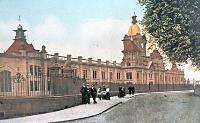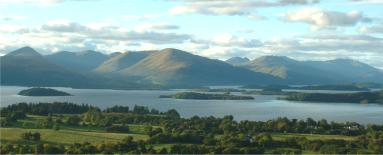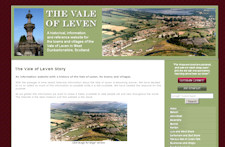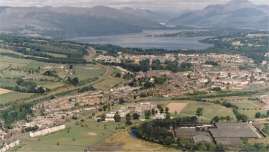ALEXANDRIA, SCOTLAND
Alexandria, the Vale of Leven and Loch Lomond
"Oh, where is the land that can boast aught so fair,
as the Queen of Scotch Lakes,
'midst' our pure mountain air?
Where are we located?
This may seem like a silly question to have on our own website but Robert Burns is popular Worldwide and it is inevitable that people from places like the USA, Canada, Australia, New Zealand and other parts of the UK will arrive at this site. This page has been provided to give them a flavour of "Oor Toon", Alexandria, and its surroundings in the Beautiful Vale of Leven.
Alexandria is one of the communities and the main town in the Vale of Leven, the other villages being Bonhill, Jamestown, Balloch, and Renton. The oldest settlement in the Vale is Bonhill whose church is mentioned as far back as 1320. The Vale of Leven was formed by the river Leven on its short, swift course from Loch Lomond to the Clyde. Locals tend to refer to the town of Alexandria as "the Vale" so if you hear someone from Bonhill saying that they are "going to the Vale", they probably mean that they are heading for Alexandria. Quite confusing!
There has always been a friendly rivalry between the communities. you will often hear remarks as such as, "Watch him, he's a B'nill man!" Or, "Watch your wallet, he's a Renton man!"
"Where cloth is printed,
dyed and steamed,
bleached, tentered, in the water streamed,
starched, mangled, calendered and beamed
and folded very carefully"
These words from Donald McLeod's, "Dumbarton, Vale of Leven and Loch Lomond" tell of the many processes involved in the textile industry, which contributed greatly in the transformation of the Vale from a rural, farming community to one that was highly industrialised. In the early 18th century the local population was about 300, mainly involved in farming and fishing.
This changed dramatically with the birth of the dyeing industry in the area. This activity was based upon the endless flow of fresh, clean water that flowed down the river Leven through the Vale of Leven from Loch Lomond. The population of the Vale of Leven rose twenty fold, to around 9,000 by the 1870's.
Statistics from "Reminiscences of Bonhill Parish", by John Neill, 1912
| Year | Population | Births | Deaths | Marriages | Deaths per 1000 |
| 1855 | 7643 | 253 | 127 | 43 | 16.7 |
| 1861 | 8866 | 335 | 160 | 47 | 18.0 |
| 1866 | 8866 | 305 | 162 | 87 | 18.3 |
| 1877 | 9406 | 345 | 172 | 118 | 18.3 |
| 1881 | 12,524 | 451 | 205 | 121 | 16.4 |
| 1885 | 12,524 | 508 | 245 | 124 | 19.5 |
| 1891 | 14,372 | 439 | 265 | 115 | 18.4 |
| 1901 | 14,581 | 432 | 248 | 122 | 17.0 |
| 1906 | 14,581 | 412 | 236 | 132 | 16.1 |
| 1908 | 14,581 | 419 | 180 | 115 | 12.3 |
| 1909 | 14,581 | 407 | 202 | 92 | 13.8 |
| 1910 | 14,581 | 359 | 191 | 96 | 13.1 |
| 1911 | 15,969 | 400 | 192 | 113 | 12.0 |
The Vale of Leven has historically produced many famous sportsmen and athletes. During the second half of the nineteenth century the big games were shinty, cricket and of course, rowing. The Vale of Leven Football Club was formed in 1872 and it was not long before they were making their mark in Scottish Football. Along the road "The Renton" and Dumbarton also had prominent teams. For a few years they were amongst the top teams in Scotland.
In 1877 the Vale were the first team to take the Scottish Cup out of Glasgow after beating Glasgow Rangers in the final. Team: W. Wood(G), A. Michie, A. McIntyre, W. Jamieson, A. McLintock, John Ferguson, R. Paton, J. McGregor, D. Lindsay, L. McDougall and J.C. Baird. The Vale went on to win the cup again in 1878 and 1879 and were beaten finalists in 1883 (by Dumbarton), in 1884 (by Queen's Park), in 1885 (by Renton) and in 1890 (by Queen 's Park).
Round about this time professionalism took its toll and of course teams from wee toons like the Vale of Leven could not compete against big city clubs like Rangers, Celtic and Third Lanark. Prophetically, in 1912 John Neill wrote in his book ...
"It is a matter of wonder to many how a club team, having such a record as the Vale of Leven had when the game was practically in its infancy, and when they had little experience, can have fallen so greatly from its former high position. One thing is that young promising local youths are not encouraged as they ought to be, whereas outsiders with a faint show of ability are signed on so freely , and as often as not prove failures. Local men who can easily be got together for training and practice, and animated with an esprit de corps, generally prove in the end to be better men
Then as now!
 This industrialisation continued with the building
of the Argyll Motor Works at the beginning of the 20th century. The
motor works was an amazing project at the time. It was opened in
1906 when the Argyll Motor company moved to Alexandria from
their Glasgow, Bridgeton premises. In it's day it was the most
modern factory in Scotland and no expense was spared in its construction.
This industrialisation continued with the building
of the Argyll Motor Works at the beginning of the 20th century. The
motor works was an amazing project at the time. It was opened in
1906 when the Argyll Motor company moved to Alexandria from
their Glasgow, Bridgeton premises. In it's day it was the most
modern factory in Scotland and no expense was spared in its construction.
The factory had a troubled existence not least because its main founder, Alexander Govan died suddenly in 1907. The factory continued in motor manufacturing until 1914 when it eventually went into liquidation. The plant was then taken over by the Admiralty who converted it into the Royal Naval Torpedo Factory (RNTF).
This created stable employment for Vale people until 1970 when it was bought over by the Plessey electronics company, who closed it down after stripping it of its many assets.
The facade of the building stands to this day where it is still in use after being reopened as a shopping mall in 1997. Another main employer during this period was the British Silk Dyeing (BSD) or as it was more commonly known, "the "silk factory". The United Turkey Red (UTR) plant was also a major employer until its closure in 1964.
In the early 1950's an Industrial Estate was built in Strathleven. This brought greater prosperity to the Vale. Major employers such as the Burroughs Adding Machine company, Westclox and Polaroid set up manufacturing plants that at one time employed thousands of people. They gradually closed as the new technologies rendered many of their products obsolete.
Polaroid still have a presence there but the advent of the digital camera destroyed the instant film business. They have now been taken over by a company called Stylemark.They now produce only the lenses for sunglasses and they have recently been awarded a contract for the new 3D TV glasses. this should ensure that the hundred or so jobs still there are safe for the near future at least.
During the 1970's a "modernisation" plan saw most of the Old Vale being torn down in favour of a plethora of gray, roughcast "architecture". This was supposed to be an upgrade but in fact it was probably the worst thing that ever happened to "oor toon". Those responsible should be thoroughly ashamed of themselves. A member of the Alexandria Burns Club, our local "Bard o' the Vale", Duncan McLean, wrote a nostalgic poem about what they had done. This was called "The Wail O' the Vale".

Loch Lomond
(Click to Enlarge)
Note: The image of Loch Lomond was taken from the top of Duncryne Hill in Gartocharn, known as "the Dumpling" to locals. You can click the image to enlarge it and it may be freely downloaded as long as it is not used for commercial purposes.
Despite all of these hard times Alexandria and the Vale survive to this day and the local area is showing signs of improvement, mostly because of its proximity to new Loch Lomond National Park, which was created in 2002. We can only hope that these improvements lead once again to greater prosperity for the Vale.
Read about the bard's trip down Loch Lomond side.



